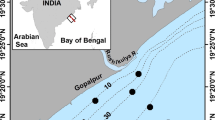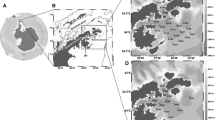Abstract
During 2015–2016, a strong El Niño event, nicknamed the “Godzilla El Niño,” similar to events in 1982–1983 and 1996–1997 occurred in the Pacific Ocean. Based on in situ and satellite observations, this paper aims to assess the water masses and chlorophyll-a surface distribution in the Bay of La Paz, Gulf of California, Mexico, after this event. A conductivity, temperature, and depth (CTD) rosette system equipped with a fluorescence sensor was used to obtain high-resolution measurements and surface water samples for spectrophotometric determinations of chlorophyll-a. Satellite images of sea surface temperature and chlorophyll-a were obtained for the dates when the cruise took place. The results showed the presence of three water masses: Gulf of California Water, Subtropical Subsurface Water, and Pacific Intermediate Water, the last present in Boca Grande. The highest surface chlorophyll-a concentrations observed were 4.51 mg m-3, 4.63 mg m-3, and 1.00 mg m-3 from the fluorescence sensor, spectrophotometric determination, and satellite observations, respectively. The horizontal distribution patterns for the three methods employed matched well. Despite the fact that Godzilla El Niño had several adverse effects in different regions, at the Bay of La Paz, they seem to have had no dramatic effect on the chlorophyll-a at the time of our observations, even though the values observed were higher compared to previous reports. This apparent lack of effect on the surface waters due to this climate disruption could be associated to the seasonal variability of the phytoplankton productivity, which presents a peak during autumn and winter and to the local fertilization mechanisms reported in the study area; however, further observations are required to confirm this.




Similar content being viewed by others
References
Álvarez-Borrego S, Schwartzlose RA (1979) Masas de agua del Golfo de California. Cienc Mar 6:43–63
Castro R, Mascarenhas AS, Durazo R, Collins CA (2000) Seasonal variation of the temperature and salinity at the entrance to the Gulf of California, Mexico. Cienc Mar 26(4):561–583
Changnon SA (2000) El Niño 1997-1998: the climate event of the century. Oxford University Press, New York 215 p
Coria-Monter E, Monreal-Gómez MA, Salas de León DA, Aldeco-Ramírez J, Merino-Ibarra M (2014) Differential distribution of diatoms and dinoflagellates in a cyclonic eddy confined in the Bay of La Paz, Gulf of California. J Geophys Res Oceans 119:6258–6268. https://doi.org/10.1002/2014JC009916
Coria-Monter E, Monreal-Gómez MA, Salas de León DA, Durán-Campos E (2017) Wind driven nutrient and chlorophyll-a enhancement at a cyclonic circulation in Bay of La Paz, Gulf of California, Mexico. Estuar Coast Shelf Sci 196:2990–2300
Coria-Monter E, Monreal-Gómez MA, Salas de León DA, Durán-Campos E (2018) Impact of the “Godzilla El Niño” event of 2015-2016 on sea surface temperature and chlorophyll-a in the southern Gulf of California, Mexico, as evidenced by satellite and in situ data. Pac Sci 72(4):411–422
Duran-Campos E, Salas de León DA, Monreal-Gómez MA, Aldeco-Ramírez J, Coria-Monter E (2015) Differential zooplankton aggregation due to relative vorticity in a semi-enclosed bay. Estuar Coast Shelf Sci 164:10–18
Durazo R, Baumgartner TR (2002) Evolution of oceanographic conditions off Baja California: 1997-1998. Progr Oceanogr 54(1-4):7–31
Guevara-Guillén C, Shirasago-Germán B, Pérez-Lezama EL, Obeso-Nieblas MJ (2018) Variability of chlorophyll-a concentration and halocline depth in La Paz Bay (Gulf of California, Mexico) and the relationship to Pacific Large-Scale climatic phenomena. J Coast Res 34(4):920–927
IOC, SCOR, IAPSO (2010) The international thermodynamic equation of seawater 2010. Calculation and use of thermodynamic properties. Intergovernmental Oceanographic Commission, Manuals and Guides No. 56, UNESCO (English), 196 pp
Kintisch E (2016) How a ‘Godzilla’ El Niño shook up weather forecasts. Science 352(6293):1501–1502
Klein K (2015) NOAA predicts strong El Niño. Eos, Transactions American Geophysical Union 96. https://doi.org/10.1029/2015EO035535
Kug J-S, Jin F-F, An S-I (2009) Two types of El Niño events: cold tongue El Niño and warm pool El Niño. J Clim 22:1499–1515
Lavín MF, Castro R, Beier E, Godínez VM, Amador A, Guest P (2009) SST, thermohaline structure, and circulation in the southern Gulf of California in June 2004 during the North American Monsoon Experiment. J Geophys Res Oceans 114:C02025. https://doi.org/10.1029/2008JC004896
Martínez-López A, Cervantes-Duarte R, Reyes-Salinas A, Valdez-Holguín JE (2001) Cambio estacional de la clorofila a en la Bahía de La Paz, B.C.S., México. Hidrobiologica 11(1):45–52
Mathworks, Inc (2011) MATLAB. Global Optimization Toolbox: User’s Guide (r2011b). www.mathworks.com/help/pdf_doc/gads/gads_tb.pdf
Molina-Cruz A, Perez Cruz L, Monreal-Gómez MA (2002) Laminated sediments in the Bay of La Paz Gulf of California: a depositional cycle regulated by pluvial flux. Sedimentology 49:1401–1410
Monreal-Gómez MA, Molina-Cruz A, Salas de León DA (2001) Water masses and cyclonic circulation in Bay of La Paz, during June 1998. J Mar Syst 30:305–315
Obeso-Nieblas M, Shirasago B, Sánchez-Velasco L, Gaviño-Rodriguez J (2004) Hydrographic variability in Bahia de La Paz, B.C.S, Mexico during the 1997-1998 El Niño. Deep-Sea Res II 51:689–710
Obeso-Nieblas M, Gaviño-Rodríguez JH, Obeso-Huerta H, Muñoz-Casillas SI (2014) Spatial termohaline variability, water masses and geostrophic circulation in Bahía de La Paz, Gulf of California. Rev Biol Mar Oceanogr 49(3):413–426
Paek H, Yu J-Y, Qian C (2017) Why were the 2015/2016 and 1997/1998 extreme El Niños different? Geophys Res Lett 44. https://doi.org/10.1002/2016GL071515
Parsons TR, Maita Y, Lalli CM (1984) A manual of chemical and biological methods for seawater analysis. Pergamon Press, Oxford, 173 p
Pavia EG, Graef F, Reyes J (2006) PDO-ENSO effects in the climate of Mexico. J Clim 19:6433–6438
Pérez-Cruz L, Molina-Cruz A (1988) El Niño 1983: effect on the distribution of silicoflagellates in the Gulf of California. Cienc Mar 14(3):9–38
Pérez-Cruz L (2006) Climate and ocean variability during the middle and late Holocene recorder in laminated sediments from Alfonso Basin, Gulf of California, Mexico. Quat Res 65:401–410
Pérez-Cruz L (2013) Hydrological changes and paleoproductivity in the Gulf of California during middle and late Holocene and their relationship with ITCZ and North American Monsoon variability. Quat Res 79:138–151
Pieri M, Massi L, Lazzara L, Nuccio C, Lapucci C, Maselli F (2015) Assessment of three algorithms for the operational estimation of [CHLA] from MODIS data in the Western Mediterranean Sea. Eur J Remote Sens 48:383–401
Reynolds C (2006) Ecology of Phytoplankton. Cambridge University Press, Cambridge 535 p
Roesler C, Uitz J, Claustre H, Boss E, Xing X, Organelli E, Briggs N, Bricaud A, Schmechtig C, Poteaaus A, D’Otenzio F, Ras J, Drapeau S, Haëntjens N, Barbieux M (2017) Recommendations for obtaining unbiased chlorophyll estimates from in situ chlorophyll fluorometers: A global analysis of WET Labs ECO sensors. L&O Methods 15:572–585
Sánchez-Velasco L, Beier E, Godínez VM, Barton ED, Santamaría-del-Angel E, Jiménez-Rosemberg SPA, Marinone SG (2017) Hydrographic and fish larvae distribution during the “Godzilla El Niño 2015-2016” in the northern end of the shallow oxygen minimum zone of the Eastern Tropical Pacific Ocean. J Geophys Res Oceans 122:2156–2170. https://doi.org/10.1002/2016JC012622
Schiermeier Q (2015) Hunting the Godzilla El Niño. Nature 526:490–491
Shirasago-Germán B, Pérez-Lezama EL, Chávez EA, García-Morales R (2015) Influence of el Niño-Southern oscillation on the population structure of sea lion breeding colony in the Gulf of California. Estuar Coast Shelf Sci 154:69–76
Siegel DA, Buesseler KO, Doney SC, Sailley, SF, Behrenfeld MJ, Boyd PW (2014) Global assessment of ocean carbon export by combining satellite observations and food-web models. Global Biogeochem Cycles 28:181–196. https://doi.org/10.1002/2013GB004743
Silverberg N, Aguirre-Bahena F, Mucci A (2014) Time-series measurements of settling particulate matter in Alfonso Basin, La Paz Bay, southwestern Gulf of California. Cont Shelf Res 84:169–187
Stramma L, Fischer T, Grundle DS, Krahmann G, Bange HW, Marandino CA (2016) Observed El Niño conditions in the eastern tropical Pacific in October 2015. Ocean Sci 12:861–873
Strickland JDH, Parsons TR (1972) A practical handbook of seawater analysis. 2nd edn. J Fish Res Board Can. No. 067 (167), 311 pp
Whitney FA (2015) Anomalous winter winds decrease 2014 transition zone productivity in the NE Pacific. Geophys Res Lett 42:428–431
Acknowledgments
The ship time for the Paleomar-II research cruise onboard the R/V El Puma was funded by the Universidad Nacional Autónoma de México (UNAM). We would like to express our gratitude to the NASA Ocean Biology Processing Group (OBPG) for the data products used in this study. We thank the participants of the research cruise, including the captain and crew. We acknowledge Jorge Castro by improving the figures, F. Sergio Castillo-Sandoval for technical support during the chemical analyses and Marco Belacicco for suggestions and comments. We appreciate the helpful comments by two anonymous reviewers.
Funding
Consejo Nacional de Ciencia y Tecnología (CONACYT) sponsored E. Coria-Monter during this study. This study was supported by the Instituto de Ciencias del Mar y Limnología (UNAM) (grants number 144, 145, and 342).
Author information
Authors and Affiliations
Corresponding author
Additional information
Editorial handling: Haroun Chenchouni
Rights and permissions
About this article
Cite this article
Coria-Monter, E., Monreal-Gómez, M.A., Salas de León, D.A. et al. Water masses and chlorophyll-a distribution in a semi-enclosed bay of the southern Gulf of California, Mexico, after the “Godzilla El Niño”. Arab J Geosci 12, 473 (2019). https://doi.org/10.1007/s12517-019-4636-1
Received:
Accepted:
Published:
DOI: https://doi.org/10.1007/s12517-019-4636-1




